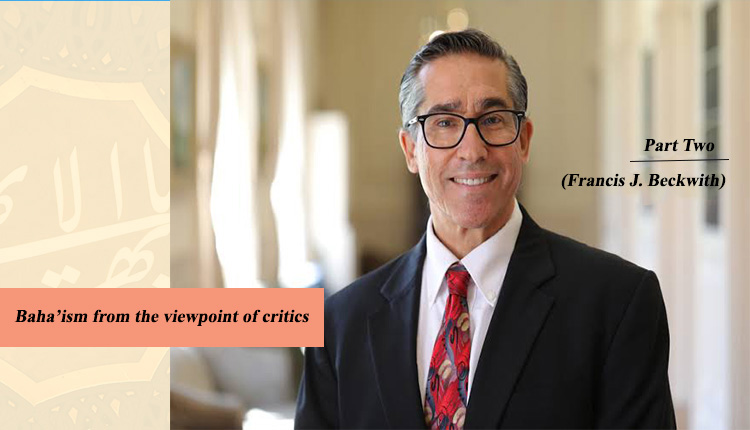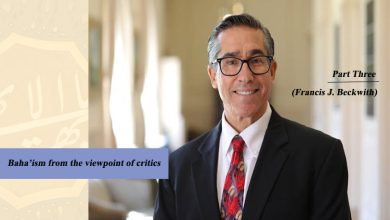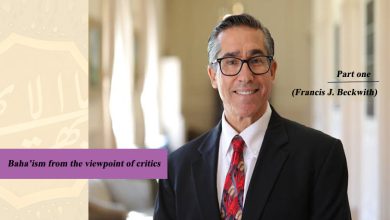
Chapter 1: A History of the Baha ’i Faith
Life and teachings of Bab
Bab, along with his followers – who were called Babis – called for drastic and radical social and religious changes. For example, the Bab advocated the promotion of women, which was contrary to the prevailing conditions of his day… Women were allowed to go to the mosque for worship at night (Bayan-i-Farsi) – although today, for Babi and Baha ‘i women, pilgrimage is not allowed, even during the day! The social and religious reforms of the Bab had other dimensions that most Baha’is are not familiar with because the works and books of the Bab are not allowed to be published from the viewpoint of the Baha ‘is. For example, in his main book, the book Bayan-i-Farsi, which contains his rulings and instructions, the Bab has prohibited learning and studying any kind of book in the field of knowledge of law, logic, philosophy, non-common languages and grammar (unit 4, Bab 10) and all Islamic books must be erased and destroyed (Unit 6, Bab 6). Another teaching of the Bab was that the kings and sultans of the Babis should force their subjects and others to become Babis, and those who do not become Babis should be expelled from the country and their sphere of influence or executed, and their property should be confiscated and distributed among the Babis. (Unit 4, Bab 2 and Unit 7, Bab 16). Of course, it should be said that according to current Baha’is, the Bab is a divine manifestation, like Buddha and Christ, but his commandments are no longer valid, because the Bab is not a divine manifestation today. Therefore, the decrees and orders of the Bab are not binding for the followers of Baha’u’llah!
The period of Baha ’u’llah’s leadership (1853-1892)
Mirza Hossein Ali Nouri, one of the followers of Bab, was the son of one of the famous Noor families in the north of Iran. Due to his kinship with Mirza Agha Khan Nouri, the chancellor, he escaped from the death penalty for those involved in the assassination of Nasereddin Shah, but was imprisoned in Tehran. This unsuccessful assassination caused pressure and harassment on Babian. Mirza Hossein Ali, during the 4-month imprisonment in Tehran and the ten-year exile period in Baghdad, found out that the person referred to by the Bab is Man Yazharullah i.e. “He Whom Allah Shall Manifest”, who must have arrived! Baha ’u’llah and his companions, after enduring bitterness and going from one exile to another, were transferred to the city of Acre. Although over time, he gained more freedom and his restrictions were reduced, he spent the rest of his life under the supervision of the Ottoman government in Acre. Although Baha’u’llah was under watch, he was able to meet with his clients and guests, send missionary and preaching delegations here and there, and write books and letters during the remaining days of his life. Among the books he wrote was his collection of laws, Kitab-i-Aqdas. This small book has been introduced as “His most precious and sacred work”. Baha’u’llah wrote letters and messages to the heads of nations, including the Pope, the leader of the world’s Catholics in which he announced his purpose and destination. He died in Acre in 1892, at the age of 75.
The leadership of Abdu’l-Bahá and Shoghi Effendi and the years after that
After Baha’u’llah, the leadership of the Baha’is passed to Abbas Effendi, his eldest son, later known as ‘Abdu’l-Bahá. Unlike Bab and his father, he never claimed to be a divine manifestation, but was only the leader of the community and the expositor and interpreter of the words and teachings of Baha. Abdu’l-Bahá, like his father, was prolific in writing and gave many lectures. After Abdu’l-Bahá’s custody and surveillance was lifted by the young Turkish officers, he spent the rest of his life traveling through Europe and North America, propagating Baha’ism and forming Baha’i assemblies.
The British Empire, in 1920, awarded Abdu’l-Bahá the title of sir and knighthood for his services. After Abdu’l-Bahá’s death in 1921, the leadership of the Bahá’í community was transferred to his grandson, Shoghi Effendi. Shoghi continued his efforts to spread the Baha’i faith. After his death in 1957, the leadership of the Bahá’ís was stopped by the children and successors of Baha’i and the leadership of the community was entrusted to a select group of Baha’is around the world. (Universal Justice) was not as easy and effortless as the Baha’is would like to make it out to be. Of course, it must be remembered that the transfer of leadership and power from Shoghi to the Baha’i representative group (the Universal House of Justice) was not as smooth and effortless as the Baha’is would like to portray it.
The tensions and conflicts that rose after Shoghi Effendi’s death caused the spread and increase of opposing Baha’i groups and caused the split. The right-wing Baha’i group (Orthodox Baha’is) organized by the rejected Mason Remey has differences on the issue of the unity of the great world religions with the view of the Haifa Baha’is. Of course, their main dispute with the current governing group of Baha’is in Haifa goes back to the leadership of the Baha’i community. Orthodox Baha’is do not accept Bait al-Adl or House of Justice as Shoghi Effendi’s successor. They believe that Mason Remey was the true successor of Shoghi Effendi
Chapter 2: Baha’i Theology – Baha’i doctrine and theory about God
Baha’ism teaches that God is an unknowable entity. According to Abdu’l-Bahá, “the reality of divinity is hidden from all understanding and hidden from the minds of all people.” It is absolutely impossible to climb that high.”
“He has always been and is hidden in his essence from eternity, and remains in the truth of his eternity, which is hidden from the eyes of every human.”
The first question that comes to mind is: if the Baha’is believe in a God about whose nature they know nothing, how can they be sure of his existence?
According to Abdu’l-Bahá, one of the ways that God reveals Himself is through His manifestations. He knows and understands the attributes and perfections of God, it goes back to these holy manifestations. There is no access to anything else. The way is closed and the search is forbidden.” “For contemporary Baha’is, God is understood only through people who are known as His manifestation. With the revelation of these manifestations, all the names and attributes of God, such as knowledge and power, sovereignty and rule, mercy and wisdom, glory, forgiveness and mercy are manifested.
Shoghi Effendi writes: “The basic principle announced by Baha’u’llah, whose followers believe in, is that religious truth is relative and revelation and manifestation is a continuous and progressive process. All the popular and great religions of the world are heavenly and their basic principles are in harmony with each other, their goals and objectives are the same, their teachings are different aspects of the same truth, their functions are complementary to each other and they differ only in non-essential aspects, their mission is to present the stages of the sequence in the spiritual evolution of human society.”
In Baha’i principles, whenever there is a common belief among all major religions, unity is found. When the Baha’is find contradictory cases that are to some extent irreconcilable, when fundamental differences create an obstacle, Baha’is dismiss those differences as insignificant! In this way, the Baha’i teaching is protected from any criticism about the contradictions between the teachings of the manifestations of the evolutionary revelation. We should know that being immune from criticism is a double-edged sword; because it is equally empty of reasoning. This lack of accountability is a kind of defense that deprives every religion of proof and makes its official beliefs meaningless. For example, what would you think if you were told that there is a planet a little further than Pluto, but no telescope can see it? Someone may say that this cannot be denied, but what is the point of this matter? This theory cannot be criticized, nor can it be rejected, therefore it is worthless.
Since innumerable religious movements and leaders have existed throughout history, how can Baha’ism distinguish the true form from the false form? To solve this problem, the Baha’is have proposed criteria. The following is a list of the main criteria found in Baha’i literature:
1-the greatest proof of the truth of his mission is his own person.
2- Every prophet in his appearance, as part of his credibility, takes action to fulfill the correct promise of the previous manifestation and predicts the continuity of his mission line before his death.
3- Whether a manifestation says in his prophecy: “I will come again” or says: “Someone else will come like me”, the meaning is the same! And the meaning in both statements is testimony to the continuity of revelation. It is not recorded in any mission line that a person has returned to earth to continue his work.
4-Each takes over the work from the previous person and continues until he hands over the completed work to his successors.
5- As a human being, he is known for his simplicity, decency and lack of ambition. He is often born from low-level parents and is anonymous and empty-handed. He is always an almost illiterate man.
6- These holy souls are free from any sin and purified from any mistake.
7- These holy messengers in their lives reveal divine attributes such as love, mercy, justice and power in a degree beyond the capacity of ordinary people.
8- The magnanimous Prophet always mentions the name of God, not just a title, but an attribute; in the sense that he gives a new attribute by which God is understood to human consciousness, a more complete concept of God.
9- He unites people. the people who were rejected for a long time due to racial and class prejudices, find themselves united with others with strong bonds, harmony and compassion.
10-He has nothing to do with external powers, but transforms hearts. He transforms the economy of nations by transforming people’s hearts, not by displaying foreign power, and the results of his actions are not immediately emerged.
Now let’s take a closer look at the faces that Baha ‘is recognize as divine manifestations. In 1908, Abdu’l-Bahá said that the manifestations of God are Abraham, Moses, Christ, Muhammad, peace be upon him, the Bab, and Baha’u’llah. In October 1912, he also said that the manifestations of God are Jesus, Zarathustra, Krishna, Buddha, Confucius and Muhammad (PBUH), in addition to the Bab and Baha’u’llah. The Báb, who came before Baha’u’llah and Abdu’l-Bahá, also introduced Adam as one of the manifestations. Baha ’u’llah said that the manifestations of God are Noah, Hud, Saleh, Abraham, Moses, Jesus, Muhammad (PBUH) and the Bab. According to another list, these nine people revealed the world religions of Sabeii, Hinduism, Judaism, Zoroastrianism, Buddhism, Christianity, Islam, Babism and Baha’ism. However, according to Hugh Chance, the nine religions that the Baha ‘is recognize are Hinduism, Zoroastrianism, Buddhism, Confucianism, Taoism, Judaism, Christianity, Islam, and Baha ism!
However, authoritative Babi-Baha’i sources, at another time, confirmed these people as manifestations of Divine Right: Adam, Noah, Abraham, Moses, Krishna, Zarathustra, Jesus, Buddha, Confucius, Muhammad (PBUH), Hud, Saleh, Bob and Baha. Although Baha’is have currently declared only nine persons as divine manifestations, they have never denied the validity and acceptance of others. Because such a denial means that the Baha ‘is will go into conflict with the officials who have already confirmed their position and manifestation, and this is not possible.
Baha ism and Jesus Christ
To assess the main Baha ’i teachings, we examine the Baha ’i view of Jesus Christ. Traditionally, in Christian theology and the New Testament, it has been said that Jesus Christ has distinguishing characteristics that set him apart from other human beings. Four of these features are:
1) He is a special creation and the word of God.
2) He has ascended to heaven with material body.
3) He comes back with his material body and returns to the earth.
4) He is the savior and intercessor of the human world.
The Baha’is do not accept these beliefs. What they believe is that Baha’u’llah, as the manifestation of God, is the same Messiah who has returned. The Baha ’is attempt to justify this belief by quoting prophecies from the Bible, which, according to Baha ’i interpretation, apparently apply to Baha ’u’llah. Abdu’l-Bahá writes about the Second Coming of Christ:
“In the first return, he comes from the sky, although apparently it is from the mother’s womb. In the same way, in his second return, he comes again from the sky, although apparently he is from the mother’s womb!
It is clear that Baha ‘ism denies the traditional belief of Christians about the ascension and return of Jesus Christ with a material body. When Abdu’l-Bahá was asked about the meaning and importance of this issue, he replied:
“The ascension of the divine manifestation is not with a material body… His ascension from the earth is symbolic; This is a spiritual and sacred truth; also, his return is spiritual, not physical!” He continues… the truth of Christ, which implies his teachings, forgiveness, perfections and spiritual power, remained hidden for two or three days and was not revealed and manifested… and when the apostles began to publish his spiritual teachings, the truth of Christ manifested and his forgiveness appeared; his religion found life again, his teachings and guidelines became evident and appeared.
Simply put, Baha ‘ism interprets Christ’s resurrection as merely symbolic or spiritual. From the viewpoint of Baha ’ism, it was his words and teachings—not Christ himself—that found new life to empower the Church to spread Christianity and fundamentally transform the Roman Empire.
Chapter 3: Criticism of Baha ’i beliefs about God
What follows are details about the nature of God as taught by the seven leaders and manifestations that the Baha ’is identify as previous manifestations:
Moses (1200 years BC) believed in a single God who was the creator of the world. According to Deuteronomy 4:6, Moses said: Hear, O Israel: God, our ruler, is one. So he affirmed the Jewish belief about Yahweh that God is one.
Krishna (650-850 BC) taught that there are many gods:
By sacrificing, you must honor the gods so that they will love you… If they are satisfied with your sacrifice, the gods will grant you happiness in all your desires.
Krishna also taught that everything is a part of that Supreme Being, that is Brahman: He is invisible; he cannot be seen. He is far and near, He moves and does not move, but is within and without everything. He is one in all, but seems to have been many. He supports all beings and creation and decay belong to him. When man sees that the infinity of different beings has settled in that “one” and evolve from that one, then he becomes one with Brahman.
Krishna also claimed to be an incarnation (avatar) of the Hindu god Vishnu. So for Krishna, there are many gods (polytheism), but in the real world, along with all existence, part of the Supreme God is Brahman (unity of existence).
Zoroaster (600-700 BC) taught that there was a good god named Ahuramazda and an evil creator named Angra Mainyu. He learned that “the special name ” Angra Mainyu ” refers to a great hostile spirit, although it is mentioned only once in Zoroastrian teachings,” but the text clearly states “that since the beginning of existence, two incompatible natures and two opposing spirits have existed in the world (Yesna 45:2).”
Siddhartha Gautama (480-560 BC, better known as the Buddha), “did not teach monotheism and individual worship or prayer.”
“There is no category for God… because there is no belief in God in Buddhism. The Western god-worshipper should not expect from Buddhism an image of God like the Bible or the Qur’an”.
Although there are many sects of Buddhism in modern times that consider the Buddha or other beings to be God, the main teachings of the Buddha do not deal with God as a relevant subject.
Confucius (497-551 BC) believed in the unity of existence and believed that the need for social order is more important than honoring the gods. Lewis Hoff writes: Confucius seems to have believed that since existing gods and worship and rituals were only worth bringing people together, these things were of secondary importance compared to a just social order.
Jesus Christ taught that God is a real (personal) thing (Luke 23:34), He is superior to the material world (John 4:24) and that God created Himself (John 8:58). Jesus taught the basic Jewish view and concept of God: The One Omnipotent Almighty God.
Muhammad (632-570 AD) taught a clear and firm monotheism, but rejected the fact that Jesus is the Son of God (Baqarah 110, Al-Nisa 169, Ma’idah 77-76, An’am 100-102).
God and the leaders of the great religions of the world
It seems that there is a difference between the alleged manifestations of Baha ‘ism regarding the introduction of God. Although Shoghi Effendi has said that the divine manifestations only differ about the “non-essential dimensions of beliefs”. This can lead to the idea that the nature of God is one of these unnecessary dimensions. God cannot be personal and general, special and sublime, omniscient, one, capable of having children, incapable of having children, and an important or unimportant issue! If it is true that God is all these things, then we are pushed towards polytheism. A god so irrational can never be known based on the contradictory information provided by his manifestations. Inconsistent data does not give us any knowledge about God.
Criticism of the criteria of divine manifestations
We must reject the criteria for divine manifestations presented by some Baha ’i writers, because some manifestations do not meet the criteria they should. For example, George Townsend writes: “The Holy Prophet confirms all the teachings of the previous advent…”.
Interestingly, Confucius, Buddha, Zoroaster and Krishna fail this test. Christ never mentioned Confucius, who was his predecessor. In his works, Confucius did not mention Buddha, who was a manifestation before him (and at the same time his contemporary) and there is no name of Buddha. Buddha does not refer to Zoroastrian, who was a manifestation before him. Zarathustra does not mention the manifestation before him, which is Krishna. Moreover, Krishna does not say anything about his predecessor, Moses. Townshend offers another false standard: as a human being, he is known for his simplicity and decency and lack of ambition. He always has little human education and learning.
This does not apply to Moses or Confucius. Josh McDowell and Dan Stewart write about Moses: It should be explained at the very beginning that Moses was in a position to write the five books. He was trained in the high school of Egypt, which was very advanced in terms of science.
Confucius has said about himself that “at the age of fifteen, my mind was filled with science and knowledge.” Confucius was a successful educator and started a private school that had 3,000 students. He had various interests and taught various subjects such as history, poetry, literature, physics, chemistry, government, natural sciences and music.
Another one of Townshend’s criteria is that the divine manifestation “has nothing to do with external powers, but transforms hearts.” He transforms the economy of nations by manipulating people’s hearts, not by displaying foreign power, and the results of his effects are not immediately emerged.
Jesus Christ does not fit into this category. When the Jews asked him, “What miracle can you show to prove that you have the power to do all these things?” (John 2:18), Jesus replied: “Destroy this temple, and in three days I will raise it up again” (John 2:19). According to Matthew, Mark, Luke and John, it is an external display of power that revives the hearts of the apostles and people.
Peter, the man who denied Christ three times (Luke 22:55-62), cried out to a large crowd: Men of Israel, listen to me! As you know, God performed strange miracles through Jesus of Nazareth to prove to everyone that Jesus came from him.
It is crystal clear that Christianity is based on the external power of Christ. It is the external power of Christ that has revived the inner life of many. This is the testimony and confirmation of the new covenant.
To be continued …





